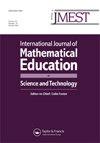为技术丰富的数学环境设计示例生成任务
IF 0.6
Q3 EDUCATION & EDUCATIONAL RESEARCH
International Journal of Mathematical Education in Science and Technology
Pub Date : 2023-09-13
DOI:10.1080/0020739x.2023.2255188
引用次数: 0
摘要
本文提供了一些关于在设计一个技术丰富的学习环境中使用示例生成任务来增强学生的数学思维的见解。本文报告了一个基于设计的研究项目的早期阶段,该项目涉及任务设计和相关反馈,利用动态数学软件环境和计算机辅助评估系统的组合使用提供的功能。在示例生成任务中,学生被要求生成满足特定条件的示例。基于491名选修微积分第一课程的工科一年级学生生成的示例数据,本文考察了学生对三个示例生成任务的反应模式。作为一个理论透镜,使用了可能变化的尺寸和相关的允许变化范围的概念。根据观察到的模式,本文提出了一些指导原则,用于设计生成示例的任务和相关的形成性反馈,通过丰富学生的示例空间来培养他们的数学理解。例如,本文举例说明了这样的情况:首先要求两个例子,然后在要求第三个例子之前得到适当的反馈,这可能是有益的。本文章由计算机程序翻译,如有差异,请以英文原文为准。
Designing example-generating tasks for a technology-rich mathematical environment
This paper provides some insights into the use of example-generating tasks in the design of a technology-rich learning environment to enhance students’ mathematical thinking. The paper reports on an early stage of a design-based research project concerning the design of tasks and associated feedback utilising the affordances provided by a combined use of a dynamic mathematics software environment and a computer-aided assessment system. In example-generating tasks, students are asked to generate examples that fulfil certain conditions. Based on data in terms of examples generated by 491 first-year engineering students, taking a first course in calculus, the paper examines patterns of student response to three example-generating tasks. As a theoretical lens, the notions of dimensions of possible variation and associated ranges of permissible change are used. In light of the observed patterns, the paper provides some guiding principles for designing example-generating tasks and associated formative feedback to foster students’ mathematical understanding by enriching their example spaces. For example, this paper illustrates occasions where it might be instructive to start by asking for two examples, followed by adapted feedback before requesting a third example.
求助全文
通过发布文献求助,成功后即可免费获取论文全文。
去求助
来源期刊

International Journal of Mathematical Education in Science and Technology
EDUCATION & EDUCATIONAL RESEARCH-
CiteScore
3.30
自引率
11.10%
发文量
123
期刊介绍:
Mathematics is pervading every study and technique in our modern world, bringing ever more sharply into focus the responsibilities laid upon those whose task it is to teach it. Most prominent among these is the difficulty of presenting an interdisciplinary approach so that one professional group may benefit from the experience of others. The International Journal of Mathematical Education in Science and Technology provides a medium by which a wide range of experience in mathematical education can be presented, assimilated and eventually adapted to everyday needs in schools, colleges, polytechnics, universities, industry and commerce. Contributions will be welcomed from lecturers, teachers and users of mathematics at all levels on the contents of syllabuses and methods of presentation.
 求助内容:
求助内容: 应助结果提醒方式:
应助结果提醒方式:


